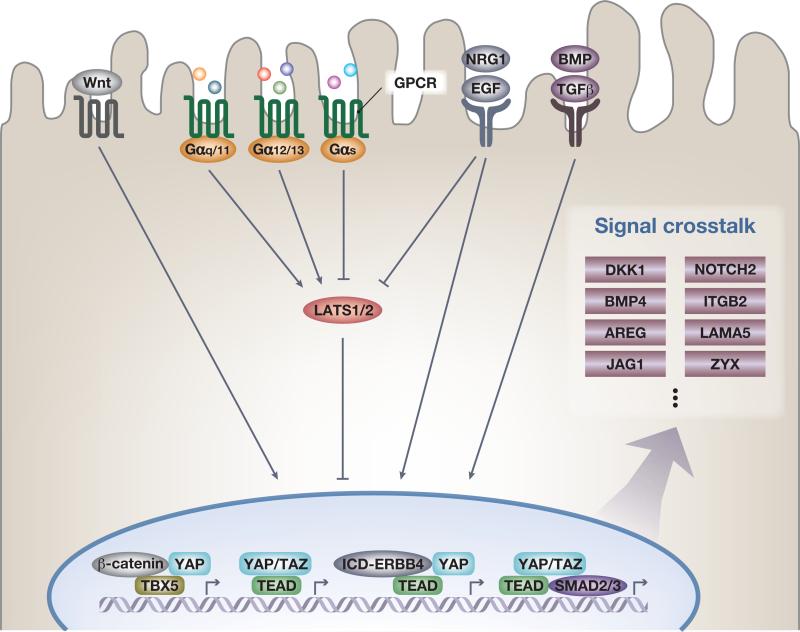Figure 4.
Signal crosstalk with Yes-associated protein (YAP) and transcriptional coactivator with a PDZ-binding domain (TAZ). Wnt signaling activates YAP and TAZ by inhibiting the formation of the β-catenin destruction complex that in some instances functions as a cytoplasmic sink and causes degradation of YAP and TAZ. Nuclear YAP can form a complex with β-catenin and the transcription factor TBX5 to promote antiapoptotic gene expression, including BCL2L1 and BIRC5. G protein-coupled receptor (GPCR) signaling is relayed via small G proteins. Activation of Gα12/13 and Gαq/11 induces YAP and TAZ nuclear translocation and activity, whereas active Gαs represses YAP and TAZ nuclear activity, which causes either activation or inhibition of large tumor suppressor (LATS) kinase activity. The family of epidermal growth factor (EGF) ligands activates YAP and TAZ in both a LATS-dependent and -independent manner. EGF receptor (EGFR) stimulation inhibits the kinase module by dissociating phosphoinositide-dependent kinase-1 (PDK1) from the Hippo pathway components [LATS, mammalian STE20-like protein kinase 1 (MST), and Salvador family WW domain-containing protein 1 (SAV1)], preventing activation of LATS by MST. EGFR–Ras–MAPK signaling also enhances the AJUBA family protein Wilms’ tumor protein 1-interacting protein (WTIP) binding to LATS, which inhibits LATS activity toward YAP. In addition, a cytoplasmic intracellular domain of the ERRB4 receptor (ICD-ERBB4) is cleaved and released on neuregulin 1 (NRG1) stimulation, which in turn binds to YAP and promotes target gene expression. On transforming growth factor beta (TGFβ) signal activation, nuclear YAP and TAZ form a complex with SMAD2, SMAD3, and TEA domain family (TEAD) transcription factors, coordinating a protumorigenic transcriptional program. YAP and TAZ also directly promote transcription of several receptors and ligands to mediate endocrine and paracrine signal crosstalk and potential feedback loops. Notable examples are the Wnt signal inhibitor DKK1, ligands of the BMP/TGFβ family BMP4, the EGF-like growth factor AREG, NOTCH2, the Notch ligand Jagged1 (JAG1), integrin/extracellular matrix (ECM) signaling components such as β2-integrin (ITGB2) and the α5 subunit of laminin 511 (LAMA5), and the focal adhesion component zyxin (ZYX).

